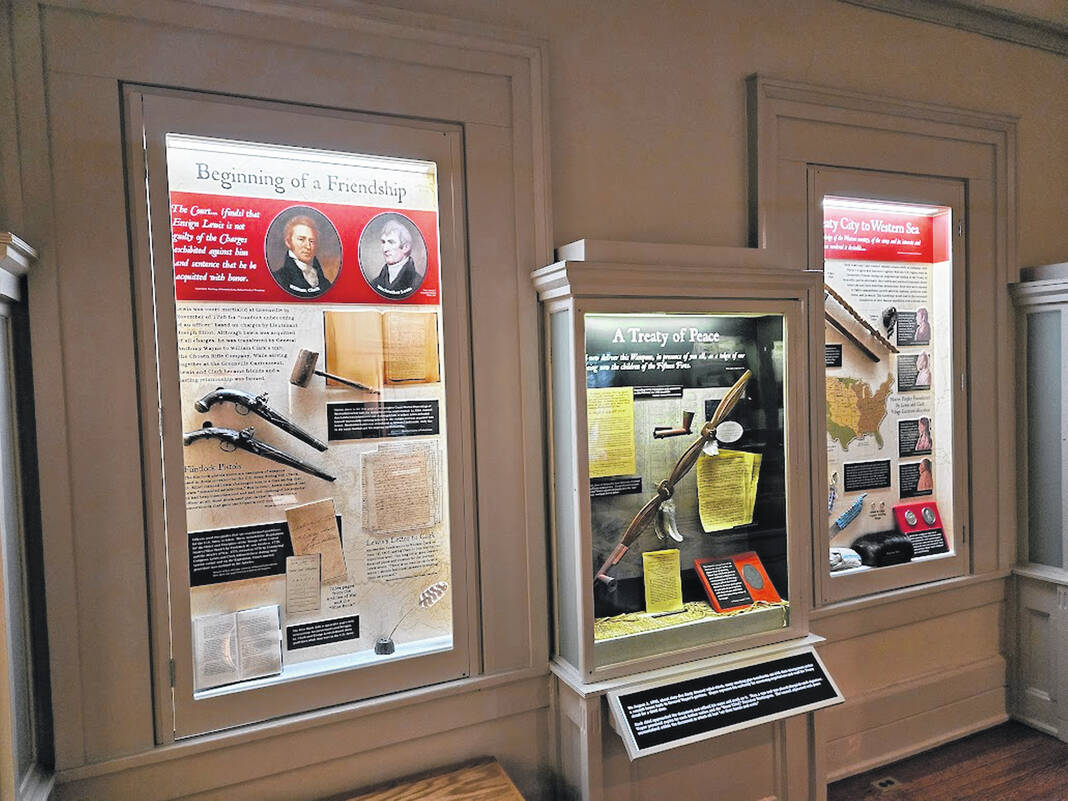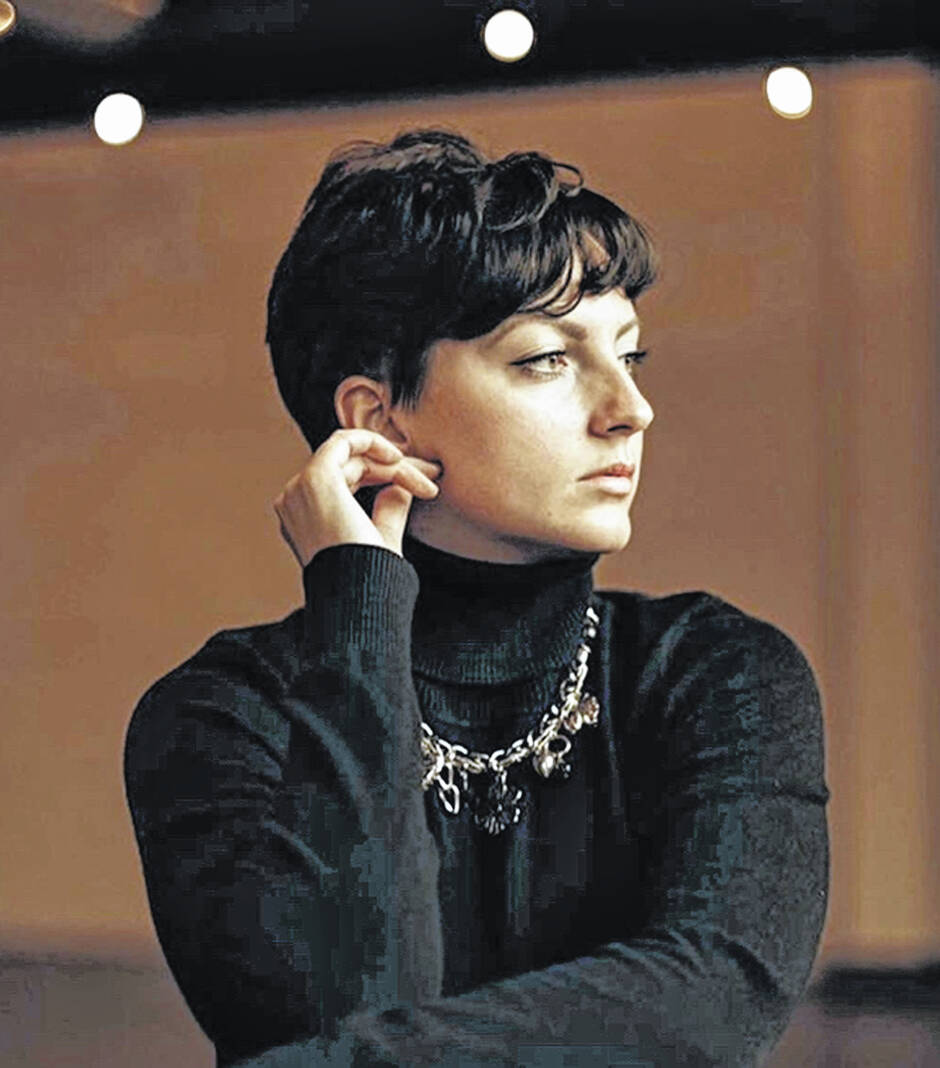
The newest exhibit at Garst Museum shares the story of Meriwether Lewis and William Clark meet at the Greene Ville fortification.
Submitted photo

Cait Clark
GREENVILLE — The Garst Museum has something new, and you can learn more about the exhibit and the inspiration behind it when the museum’s lecture series continues on Saturday, March 9, at 2 p.m. in the Lowell Thomas Meeting Room. Cait Clark, local author and expert on Lewis and Clark, will be sharing the program The Clark Expedition: Bringing Lewis and Clark Back to Greenville.
Clark will share the story of her own expedition across the country as she followed in one of her ancestor’s footsteps to gather more information and artifacts for the exhibit. Clark is a distant relative of William Clark.
In the summer of 2023, Clark set out to follow the Lewis and Clark Trail and was able to visit places like Fort Mandan near Washburn, North Dakota. This is where Lewis and Clark built a fort to winter before continuing their journey west. This is also where Sacagawea and Charbonneau joined the expedition. The expedition stayed at the fort from November 1804 to April 1805. They finally reached the Pacific coast in November 1805.
Along the Pacific coast they built another fort to spend the winter before returning home. Clark said she was able to visit Fort Clatsop in Oregon. She also attended the Lewis and Clark Festival in Great Falls, Montana and visited several other areas along the trail in North and South Dakota and Missoula, Montana.
Her personal expedition wasn’t just for sightseeing. Clark was on a mission to not only promote Garst Museum and Greenville, but she wanted to bring back items for the exhibit. Some of those items that are now on exhibit include a pipe tomahawk, peace pipe, peace medals, beaver skin, and authentic Cheyanne moccasins. There are also two flintlock pistols donated by Jon Brown and family that come from the era that Lewis and Clark completed their expedition.
Why is it important to recognize Lewis and Clark at Garst Museum? Clark believes it is because of the discovery that the duo met at the Greene Ville fortification. It has been less than 15 years since it came to light that both individuals were in Greene Ville and were able to build a friendship here. Clark said papers were found with Anthony Wayne’s artifacts that wrote about Meriweather Lewis’ court martial that took place in Greene Ville.
Clark pointed out that until that discovery, people didn’t know they met in Greene Ville and that is when research began to snowball.
“We’re trying to publicize that more because the Lewis and Clark trail runs from Pittsburgh, Pennsylvania to Oregon. It pretty much connects the coasts. That wouldn’t have happened if it weren’t for Greene Ville,” said Clark.
“Their expedition was largely successful because of what they learned in Greene Ville,” Clark boasted. She explained they learned a lot about Native American interaction from their time here. Because they were at the fortification during the time of the treaty, they learned about pipe ceremonies, how to trade with tribes and how to speak to Native Americans during councils. “They would have seen those interactions first-hand. It showed for the rest of their careers, even after the expedition, what they learned in Greene Ville,” she said.
Through their interactions, they were able to establish relations with more than a dozen Native American tribes. Their respect for the tribes is evident by the naming of the forts they built. The National Park Service shared that Fort Clatsop was turned over to Clatsop Chief Coboway for the kindness he showed the expedition.
Finding passage from the east coast to the west coast wasn’t the only mission Lewis and Clark were tasked with. They also made multiple discoveries for science. According to Clark, they introduced multiple plants and animals that were previously unknown to science. They also created one of the first comprehensive maps of North America.
However, there was one thing they were looking for they did not discover. According to Clark, the expedition was looking for the Northwest Passage, which was later learned that it does not exist.
Having Lewis and Clark and a small part of their storied careers on exhibit is a huge step in preserving Greenville and Darke County’s history. Clark said, “It’s an essential part of our history, and not only is it our history, but it shows that Greenville played a huge role in national history. We have Annie Oakley and Lowell Thomas and Anthony Wayne, but this is the Lewis and Clark Expedition. It is very well known, and it started here.”
Although Clark provided much of the research and was able to acquire some of the artifacts in the exhibit, she said putting the exhibit together was a team effort. She praised Shelly Bohman for creating the graphics in the exhibit. “It’s a team endeavor. I was happy to be on the team that I had,” she said. The Lewis and Clark exhibit was made possible thanks to the assistance from an anonymous donor.
Following the lecture, attendees are encouraged to view the newest exhibit at Garst Museum, “Beginning of a Friendship” and Treaty City to Western Sea”. However, regular admission rates apply to tour the museum. Don’t forget, you can always turn your single day admission into a membership and enjoy the museum throughout the year. Ask for more information at the front desk.
For more information on Garst Museum, visit www.garstmuseum.org or follow them on Facebook, Instagram and X (formerly known as Twitter).
The museum is located at 205 N. Broadway, Greenville. The museum is open Tuesday through Saturday, 10 a.m. to 4 p.m.




